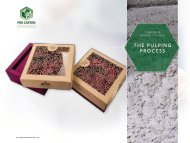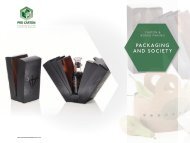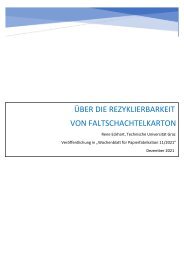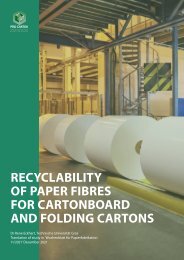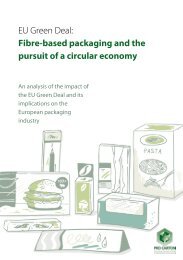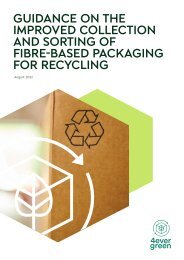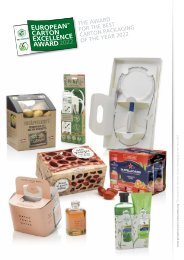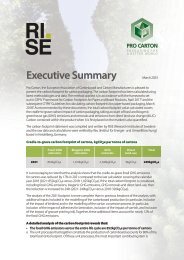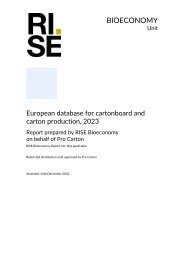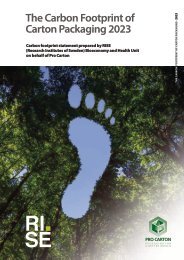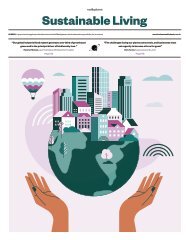European Database for Cartonboard and Carton Production 2023
You also want an ePaper? Increase the reach of your titles
YUMPU automatically turns print PDFs into web optimized ePapers that Google loves.
23<br />
Chemicals <strong>and</strong> other non-fibre inputs<br />
Data were collected <strong>for</strong> chemicals <strong>and</strong> other non-fibre inputs to the cartonboard<br />
mills which may be used either within the process or as additives. Chemicals are given<br />
as dry weight. Some of the inputs have been reported grouped together according<br />
to their function in the mill. The functional additives, mainly starch, influence the<br />
properties of the paper, whilst process additives are used to guarantee that the<br />
process of paper production runs smoothly or to increase the production. Water<br />
treatment additives include additives used <strong>for</strong> all water treatment on the site,<br />
including the treatment of water <strong>for</strong> the power station, paper production <strong>and</strong><br />
wastewater treatment if this is done internally. The different mills use a large<br />
variety of process <strong>and</strong> water treatment chemicals. Those that are commonly used<br />
<strong>and</strong> are above the cut-off criterion per mill are reported in the database. A very<br />
limited quantity of other additives <strong>and</strong> chemicals are also used, e.g. Carboxymethyl<br />
cellulose (CMC), Ethylenediaminetetraacetic acid (EDTA), Sodium hypochlorite,<br />
Polyvinyl alcohol, Alkyl succinic anhydride (ASA) sizer, talc, Polyacrylate, PEI, optical<br />
brightener, rosin. Collectively, these additional additives <strong>and</strong> chemicals account <strong>for</strong><br />
less than 1% of the material inputs to the manufacturing of cartonboard.<br />
Other than cartonboard, the main input <strong>for</strong> carton production is inks <strong>and</strong><br />
varnish, followed by glues. However, these inputs account <strong>for</strong> less than 2% of<br />
the overall composition of the cartons.<br />
Packaging<br />
Data on cores <strong>and</strong> other packaging materials associated with paper reels was<br />
not collected <strong>and</strong> updated <strong>for</strong> 2021. Looking at previous data collections, the values<br />
showed little change over the years <strong>and</strong> other LCA studies show that the impacts<br />
of these packaging components are relatively small.<br />
Data <strong>for</strong> packaging materials used around converted cartons (stretch/shrink wrap<br />
<strong>and</strong> corrugated packaging) was collected <strong>and</strong> updated <strong>for</strong> 2021. Pallets are also used<br />
in the logistic operations of the carton industry. However, data on usage of pallets has<br />
not been collected. Previous iterations of the study have shown that the reported data<br />
on the use of pallets are confusing because of the complexity of the matter. Pallets can<br />
be returnable or one-way, only used internally in the plants <strong>and</strong> produced of wood,<br />
plastic or paper/ wood combinations. Previously some plants have reported their use<br />
in number of pallets while others have reported in kilogram pallet per tonne net<br />
saleable product, making it difficult to produce a meaningful figure.<br />
Allocation of raw materials to paper grades when a mill produces<br />
multiple products<br />
The basic data <strong>for</strong> raw materials <strong>and</strong> chemical inputs are mainly based on recipes used<br />
<strong>for</strong> the production of the specific products produced at each mill (i.e., allocation based<br />
on causality). Where this was not possible, allocation was made according to the<br />
mass production of the different papers produced at the mill.<br />
© RISE Research Institutes of Sweden



